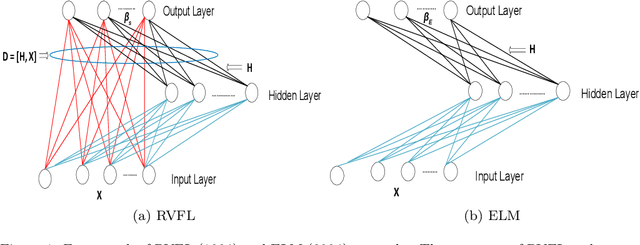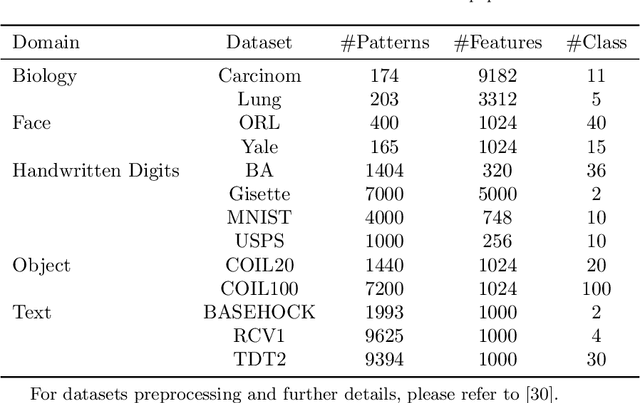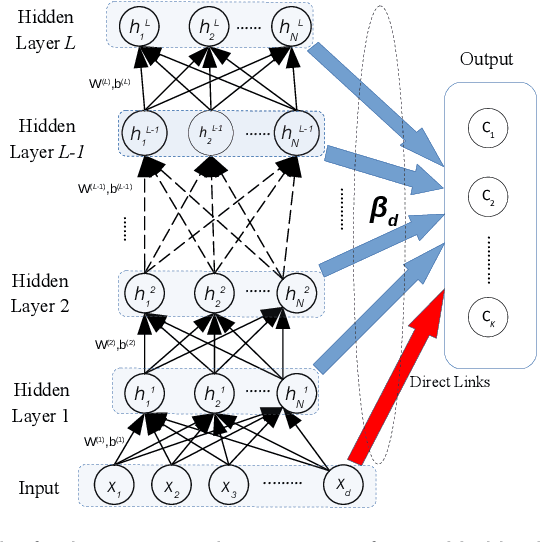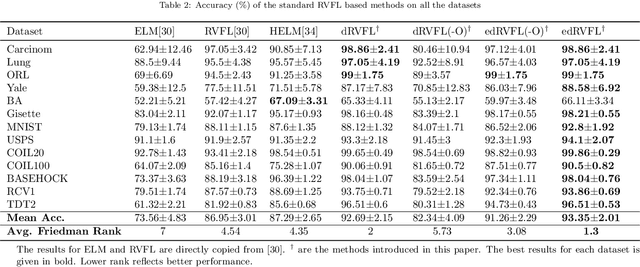Rakesh Katuwal
Weighting and Pruning based Ensemble Deep Random Vector Functional Link Network for Tabular Data Classification
Jan 21, 2022



Abstract:In this paper, we first introduce batch normalization to the edRVFL network. This re-normalization method can help the network avoid divergence of the hidden features. Then we propose novel variants of Ensemble Deep Random Vector Functional Link (edRVFL). Weighted edRVFL (WedRVFL) uses weighting methods to give training samples different weights in different layers according to how the samples were classified confidently in the previous layer thereby increasing the ensemble's diversity and accuracy. Furthermore, a pruning-based edRVFL (PedRVFL) has also been proposed. We prune some inferior neurons based on their importance for classification before generating the next hidden layer. Through this method, we ensure that the randomly generated inferior features will not propagate to deeper layers. Subsequently, the combination of weighting and pruning, called Weighting and Pruning based Ensemble Deep Random Vector Functional Link Network (WPedRVFL), is proposed. We compare their performances with other state-of-the-art deep feedforward neural networks (FNNs) on 24 tabular UCI classification datasets. The experimental results illustrate the superior performance of our proposed methods.
Stacked Autoencoder Based Deep Random Vector Functional Link Neural Network for Classification
Oct 31, 2019



Abstract:Extreme learning machine (ELM), which can be viewed as a variant of Random Vector Functional Link (RVFL) network without the input-output direct connections, has been extensively used to create multi-layer (deep) neural networks. Such networks employ randomization based autoencoders (AE) for unsupervised feature extraction followed by an ELM classifier for final decision making. Each randomization based AE acts as an independent feature extractor and a deep network is obtained by stacking several such AEs. Inspired by the better performance of RVFL over ELM, in this paper, we propose several deep RVFL variants by utilizing the framework of stacked autoencoders. Specifically, we introduce direct connections (feature reuse) from preceding layers to the fore layers of the network as in the original RVFL network. Such connections help to regularize the randomization and also reduce the model complexity. Furthermore, we also introduce denoising criterion, recovering clean inputs from their corrupted versions, in the autoencoders to achieve better higher level representations than the ordinary autoencoders. Extensive experiments on several classification datasets show that our proposed deep networks achieve overall better and faster generalization than the other relevant state-of-the-art deep neural networks.
Random Vector Functional Link Neural Network based Ensemble Deep Learning
Jun 30, 2019



Abstract:In this paper, we propose a deep learning framework based on randomized neural network. In particular, inspired by the principles of Random Vector Functional Link (RVFL) network, we present a deep RVFL network (dRVFL) with stacked layers. The parameters of the hidden layers of the dRVFL are randomly generated within a suitable range and kept fixed while the output weights are computed using the closed form solution as in a standard RVFL network. We also propose an ensemble deep network (edRVFL) that can be regarded as a marriage of ensemble learning with deep learning. Unlike traditional ensembling approaches that require training several models independently from scratch, edRVFL is obtained by training a single dRVFL network once. Both dRVFL and edRVFL frameworks are generic and can be used with any RVFL variant. To illustrate this, we integrate the deep learning networks with a recently proposed sparse-pretrained RVFL (SP-RVFL). Extensive experiments on benchmark datasets from diverse domains show the superior performance of our proposed deep RVFL networks.
Enhancing Multi-Class Classification of Random Forest using Random Vector Functional Neural Network and Oblique Decision Surfaces
Feb 05, 2018



Abstract:Both neural networks and decision trees are popular machine learning methods and are widely used to solve problems from diverse domains. These two classifiers are commonly used base classifiers in an ensemble framework. In this paper, we first present a new variant of oblique decision tree based on a linear classifier, then construct an ensemble classifier based on the fusion of a fast neural network, random vector functional link network and oblique decision trees. Random Vector Functional Link Network has an elegant closed form solution with extremely short training time. The neural network partitions each training bag (obtained using bagging) at the root level into C subsets where C is the number of classes in the dataset and subsequently, C oblique decision trees are trained on such partitions. The proposed method provides a rich insight into the data by grouping the confusing or hard to classify samples for each class and thus, provides an opportunity to employ fine-grained classification rule over the data. The performance of the ensemble classifier is evaluated on several multi-class datasets where it demonstrates a superior performance compared to other state-of- the-art classifiers.
 Add to Chrome
Add to Chrome Add to Firefox
Add to Firefox Add to Edge
Add to Edge